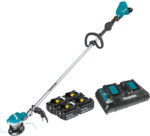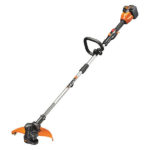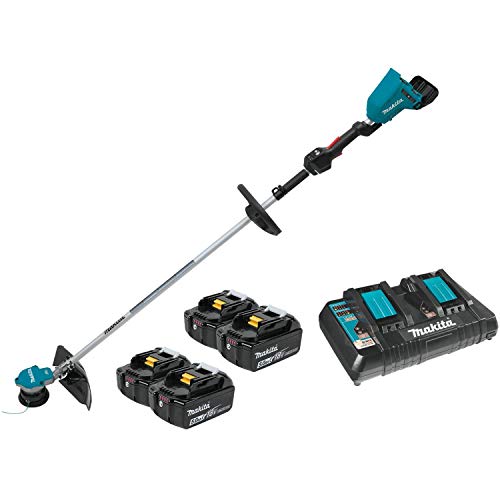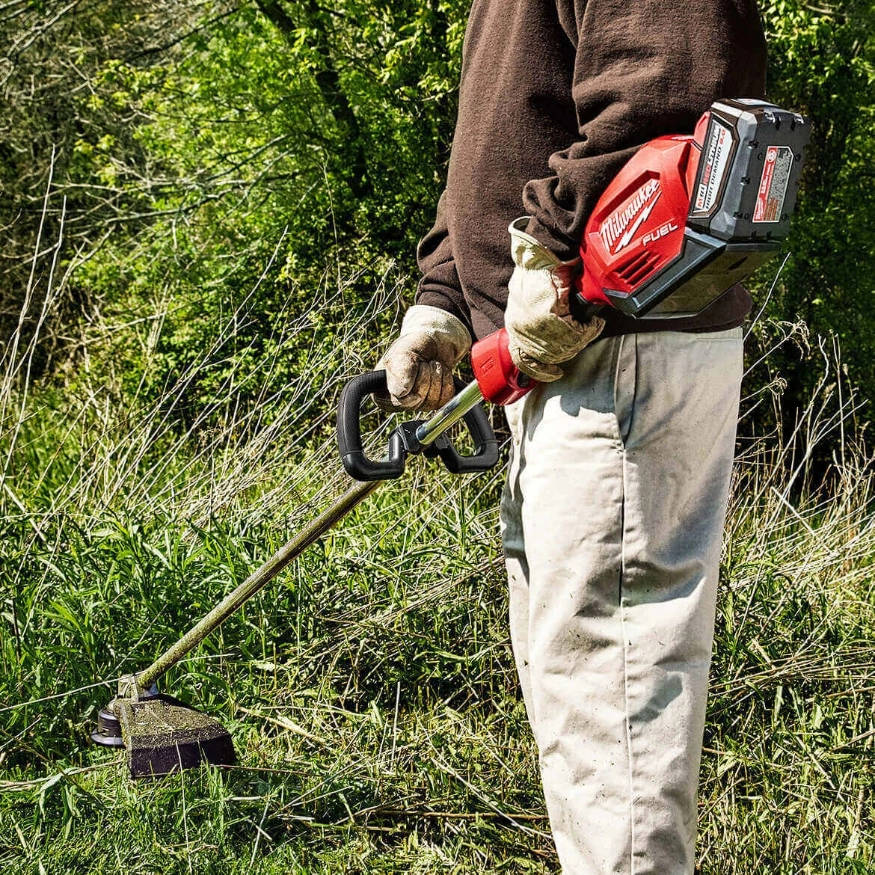As we’ve said before, Cordless Battery-Powered Tools are the way of the future. Not only does modern battery technology now rival traditional gas-powered motors, but they’re superior in many other ways.
But some models of cordless weed eaters are also far inferior to their gas powered counterparts.
That’s why choosing the right brand and model is important – you will get longevity out of your investment, and likely superior performance too.
During my stint as a professional gardener, I learned a lot about what makes a good battery powered weed eater. Battery life, charge time, build quality and power are all important factors that I looked at when putting this list together.
So before hitting that buy button, take a good read through this article and make sure the model you are considering is actually a good choice. It might just save you a lot of hassle in the long term.
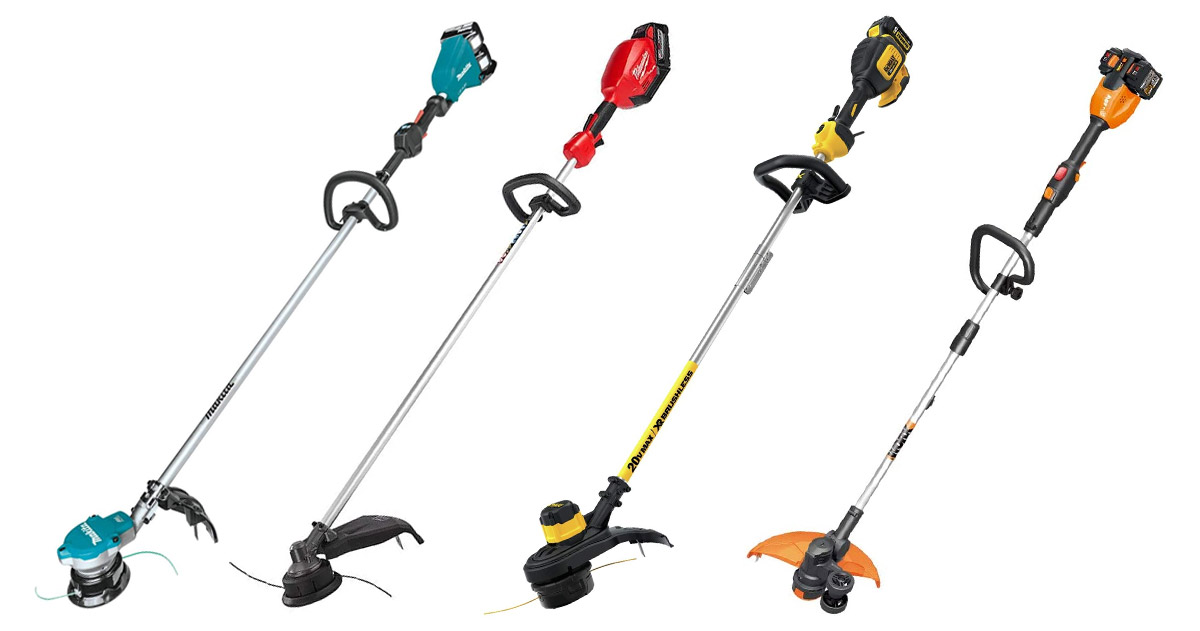
Battery Powered Weed Eater Comparison Table
Clean & Manicured Lawn: The Best Cordless Weed Trimmer Tool Reviews
The Weed Eater is known by many names. Weed Whacker. String Trimmer. Whipper Snipper. Line Trimmer. It can get confusing.
We all want to make conscientious decisions when purchasing, but between all the different names and models and brands and options, doing your own research can leave your head feeling every bit as messy as the lawn you’re trying to organize and maintain.
That’s why we’ve already done it all for you.
We’ve spent hours combing the internet and compiling a comparative review for you of seven of the best battery powered weed eaters available right now at a whole range of different price points.
We’ve focused on general specs, battery specs and bonafide user reviews, weighing the claims of the company with overall user satisfaction and experience, to bring you the ultimate go-to list of cordless, battery powered string trimmers, so you can approach this like an expert.
Here is a more detailed review that looks at the merits of each of the different models we chose, and some things to consider in finding the right one for you. For your convenience, we’ve broken them up into three subcategories: heavy use, medium use and light use.
Are you looking for the absolute best of the best?
Look no further. You want the Makita XRU15PT1 Cordless String Trimmer. It is without a doubt the best.
With the recent resurgence in people ditching the big cities for a chunk of their own land in the country somewhere, there’s been a tremendous boom in people getting back to nature, growing their own food, getting chickens, etc.
Let’s face it, being in touch with the world around us is way more important than Facebook and YouTube, and we all know it.
But to really get back to our roots, we need the right tools for the job. It’s more important than ever. There’s no point ditching the city apartment for a quarter-acre somewhere out of town if we’re just going to let ourselves get overgrown by stifling weeds.
We leave the city for the open space. And that’s exactly what a quality trimmer does, create space for us to breathe. If you want a big space, you need a trimmer that has the chops for the job.

Now, to be fair, it does weigh the most of all the battery powered models we looked at, but that’s because it’s the most heavy-duty, industry-capable and long-lasting – it uses a brushless motor, and it’s still under ten pounds!
If the weed situation in your lawn has spiraled out of control, you don’t have to run back into the house or pause your yard work. Why? Its battery lasts longer than any other cordless weed eaters – you get as much as 1-hour run time with each battery.
User reviews are overwhelmingly positive – it got 4.8 stars on Amazon, by the way. In fact, the only real piece of criticism we could find was that the bump-head wore down too quickly for the users’ liking.
However, they also conceded to bumping it repeatedly on concrete against the manufacturer’s recommendation, and virtually every weed eater with or without a battery powered system has user reviews claiming worn-out heads, so it’s really a non-sequitur. And heads are easily replaceable.
The Makita XRU15PT1 offers the right balance of power, usability, and features to tackle the simplest to the most difficult lawn jobs. If you’re after a one-time investment, this is definitely the best trimmer model for you.
Coming in second place of the best cordless weed whacker is the Milwaukee 2825-21ST – it’s a pretty close second! Let’s talk about its shortcomings first – power. This Milwaukee string trimmer model doesn’t quite have the awesome power of the Makita, or charge quite so quickly but it’s still a top-of-the-line piece of lawn equipment in every other way.
The 60-minute charge time and 60-minute run time also mean that if you splurge and grab yourself a second battery, you can use them on rotation, switching them out every hour, like our best choice – the Makita cordless trimmer.
However, if you are willing to splurge that little bit extra for the second battery pack, you’re really better off just getting the Makita battery-powered trimmer, because the price of a second battery more than makes up the difference between our number 1 and 2 picks.
Our next two battery-powered models are a step down in weight, power, battery capacity, and run time, yes, but for those small trades, they are about half the price of the first two.
If you have a medium-sized suburban home, and maintaining your lawn and garden is only of medium importance to you, you may not be looking for the absolute best of the best when it comes to maintenance tools – you’re after value for money.
You might just want a cordless weed trimmer that can provide you with 30-45 minutes at a time every few weeks. Of course, a trimmer model that won’t flatline on you within 6 months.
3. DeWALT DCST922P1 String Trimmer

Also available at Ace Hardware
Key Features:
- Voted best brand for tools
- Light but strong
- 14-inch cutting width
- 3-year warranty
The DeWALT DCST922P1 is pretty comparable product to the Worx. Amazon sells this model with a battery – so you won’t have to chase up a suitable one like you do from other vendors.
If your main use is edging your lawn along the fences, garden beds, pavement and driveway, then this is a great choice. This model has plenty of power to cut through any lawn just fine.

The biggest advantage to the DeWALT battery-powered model is the weight. For the power this unit provides, it is quite light. The DeWALT weighs just over 13lbs. This cordless and battery powered string trimmer makes it a lot more amenable to women and those of the middle ages and above.
Also, if you have other DeWALT tools, most run on the same 20V MAX battery, so you can interchange them as necessary.
However, you’ll have to extend your patience with charging – like really. If our best trimmer choice will only take 45 minutes to charge, this DeWALT trimmer can take 240 minutes or 4 hours. Yes, that long. So, in case your weed situation is minimal or you prefer something lightweight, this DeWalt model is the right trimmer for you.
Also available at Ace Hardware
The Worx WG184 Trimmer is a fantastic medium-use product. Like the Makita, it runs on double battery, giving you double the voltage for extra cutting power, and is the only other weed eater with a 60-minute fast charger.
Due to the smaller capacity of both batteries compared to the top-of-the-line battery-powered models, however, you only get 30-45 minutes of weed cutting time before you need to recharge, but that should be sufficient for the needs of the average suburban home with minimal lawn care.
Our last three trimmers are in the lighter-use category. They’re all under 6.5lbs, smaller capacity, smaller cutting width, not really designed for heavy brush or all-day use, but they also all come in at under a hundred bucks.
If you’ve been wrestling with the idea of even getting a battery powered string trimmer, because your lawn maintenance needs are pretty minimal, one of these models will suit your needs without breaking the bank.
This Greenworks 40V Cordless String Trimmer is a little heavier than other string trimmers. It also has a shorter battery life. But what it lacks in these categories, makes up for in functionality.
In addition to a wide 13-inch cut path, this trimmer can transform from weed whacker to lawn edger with the press of a button. The head rotates 90 degrees to rest on a wheel for easy, even edging with less strain on your hands.
The head is fully adjustable to four different positions, making it simple to get the right angle for whatever task you have in mind.
This maneuverability and a lower noise output make the Greenworks 13-inch trimmer a user favorite for anyone with a small to medium yard who doesn’t mind a little extra weight.
The Black+Decker LSTE525 Trimmer is almost directly comparable to the Worx WG163 in almost every way; price, voltage, cutting width, etc, except in two things: weight and capacity/runtime.
Like most Black+Decker machines such as their hedge trimmer models, this trimmer is sturdy/solid and long-lasting. However, it’s a full pound heavier than the Worx.
Capacity-wise, it comes with two 1.5Ah batteries, meaning that you only get a maximum of about 30 minutes runtime between both batteries, and again, unless you get a fast charger, it will take 3+ hours to charge it up. If you have a small and well-maintained lawn, you won’t have a problem with this battery-powered model’s 30-minute run time.
The Black+Decker LSTE525 Trimmer and Edger is available from Amazon.
Capping off our best trimmer list is the Earthwise LST02010 Trimmer, and it’s a pretty special little product. Coming in at 4.4 pounds with a 10” cutting diameter, this battery powered string trimmer is so lightweight that your 80-year-old grandmother could use it. And if you’re tight on cash, you’re looking at the least expensive trimmer that offers a reasonable value.
In fact, this piece of equipment is so affordable you can forget about Craigslist entirely. This tool is perfect for 15-20 minutes of use on lawn and light weeds, and it’s nice and compact for easy storage.
So regardless of your price range or lawn care maintenance needs, there’s clearly something quality available for you.
The Earthwise LST02010 Cordless String Trimmer is available from Amazon.
What To Look For In The Best Battery Powered Weed Eaters
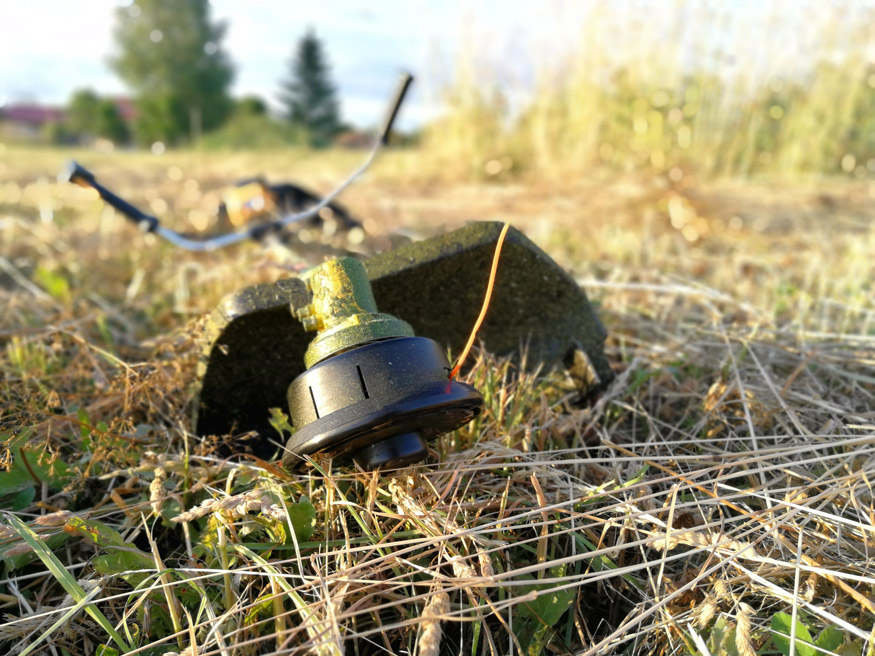
Now, if we’ve already sold you on one of those particular weed eaters and your search is done, excellent. You are welcome. Our whole purpose here is for you to be able to make the most informed choice possible. Thank you for coming.
For those of you that haven’t quite made up their mind yet, we’re going to go through the basics of everything else you might want to consider when buying a trimmer built with a battery-powered system, so that you can look at the specs yourself and understand what it all means.
Battery Type: What is the Best Choice for A String Trimmer?
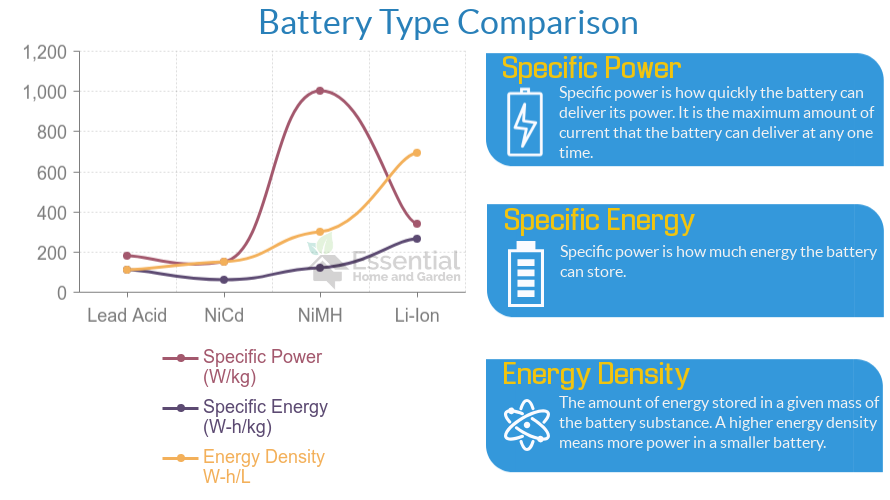
Whether it be a saw, a leaf blower, or grass shears, any cordless tool uses a battery. Even your smartphone and laptop run on battery. There are 4 main types of batteries that you should be aware of.
- Lithium Ion (Li-Ion)– Lithium Ion batteries are the preferred/most common type of battery because of their superior energy storage capabilities. Your phone, laptop, and tools are probably all Li-Ion because you can store more power in a smaller space.
- Nickel Metal Hydride (NiMH)– Nickel Metal Hydride batteries provide a greater immediate power due to less resistance, but tend not to last as long. They are ideal for flash photography, high-lumen flashlights, etc.
- Nickel Cadmium (NiCd)– Nickel Cadmium batteries are less common in household tools than, say, smaller everyday batteries (AA, AAA, etc.) because of their inferior storage per size. However, they are about 3 times cheaper to produce than Li-ion and half the price of NiMH, live 2-3 times as many life cycles and are less negatively affected by extreme temperatures. They need a deep discharge monthly.
- Lead Acid– Lead Acid batteries tend to be used exclusively in vehicles, cars, tractors, ride-on mowers, four-wheelers, etc. They’re more resistant to discharge, environmental factors and have higher CCA (cold-cranking amps).
Related: The Complete Cordless Tools Battery Guide
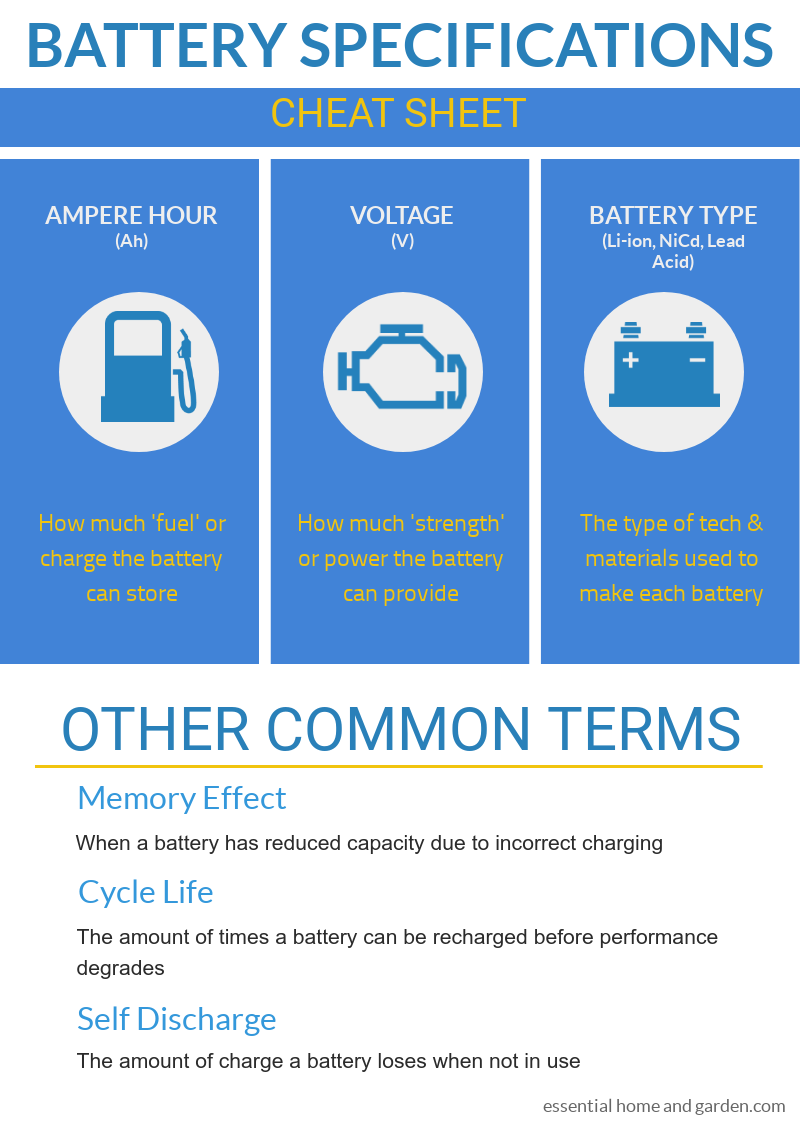
Battery Voltage Of The Best Battery Powered Weed Trimmer
You can imagine your electrical circuitry a lot like a water pipe. If your water pipe is two feet wide, you have a maximum capacity of about 23.5 gallons per foot of pipe. But you might only have 5 gallons per foot of water coming out of your “battery” storage facility and flowing through the pipe at any given time.
More gallons of water per foot would provide more power to the turbine/water wheel that’s driving your engine/motor at the end. But how much water it is given all depends on how big the drain or “hole” connecting your battery and pipe are. A big “drain/hole” in your battery might let 20 gallons per foot through the pipe, smaller ones might only let 10 or 5 or even 2 gallons per foot. This is how voltage works. More voltage = more power.
Power: Battery Capacity/Size
Battery size is measured in ampere hours (Ah). To understand it, you need to understand what amperes are.
Let’s go back to our water-pipe analogy.
The ampere is the speed of flow. So in our water pipe, that might be 1000 gallons per hour, regardless of the voltage (how full the pipe is). Let’s say that that is 1 ampere.
We measure the capacity of our battery by how many hours of amperes can flow out of it until it is empty. In our analogy, a 10,000-gallon tank at a flow rate of 1000 gallons per hour would take 10 hours to empty completely.
We’d say the capacity/size of the battery was 10 ampere-hours.
Now, if you changed the flow rate (amperes) by tilting the pipe to a steeper angle so that 2000 gallons per hour (2 amps) travelled through it, your 10Ah battery would drain in 5 hours.
Likewise, if you went even steeper to 5000 gallons per hour (5 amps), your 10Ah battery would drain in 2 hours.
And if you somehow managed to get your flow up to 10,000 gallons per hour (10 amps), your 10Ah battery would drain completely in a single hour.
Battery Run Time and Charging Time of A String Trimmer
This one is really straight forward.
The run time is how long it will take your battery to drain completely using that piece of energy-sucking equipment.
The charge time is how long it will take your battery to be fully refilled after draining.
Our best battery-powered trimmer, the Makita XRU15PT1 Cordless String Trimmer, can give you 60 minutes of run time if fully charged up to 45 minutes.
Weight: How Heavy A Cordless Weed Trimmer Should Be?
Every modern weed eater weighs under 10lbs, and the cheaper models weigh quite a bit less than that, so the weight isn’t something you probably need to even think about unless you’re going for something top-of-the-range.
A heavy-use battery-powered trimmer will tire you out after extended use, but most of that weight can be easily negated with a strap, sling or harness.
Design of A Battery-Powered Trimmer: Straight Shaft Vs Curved Shaft?
Traditionally, there are two main designs when it comes to weed eaters: straight shaft or curved shaft.
Straight-shaft trimmers are generally more sturdy, have better reach, more torque and can be used for more purposes.
Curved-shaft trimmers are generally lighter, quieter, will vibrate and are more limited to edging.
It’s worth noting, however, that curved-shaft trimmers with battery-powered systems have mostly become obsolete in favor of short, straight, extendable shafts as can be seen in the cheaper models above.
Learn more: Have you considered battery powered shears?
Warranty
A limited warranty is a safeguard from manufacturers for your product, and here’s a secret…
Most people don’t use them.
For a period of one to three years (depending on the particular brand/company) from the date of purchase, if the product breaks in some way that appears to be a manufacturing fault or defect, and not abuse by the customer, the manufacturer will either repair, replace or refund the product free of charge.
Most of the brands above have two- or three-year warranties on their tools and even one-year warranties on their batteries.
It’s worth keeping track of your warranties and receipts on covered items like tools in case something malfunctions. A lot of people throw out warranties with the packaging when unboxing their products, but statistically, in the long run, you’re bound to save a pretty penny.
How To Use a weed eater or string trimmer
- Make sure you are wearing the correct safety equipment
- Some weed eaters actually work better when turned upside down
- If using your string trimmer upside down, use your thumb to control the throttle
- Use the very end of the spinning trimmer line to cut the grass
- Move slowly along the edge, being careful to watch where you are stepping
There is of course a lot more to it than this, watch the video below for a more in-depth guide.
Battery-Powered Vs Gas: What About Gas Models?
A cordless electric string trimmer is best suitable for households with a small backyard and minimal weed growth on the lawn. However, there are some occasions where you may want to consider a gas weed eater instead of a battery model.
FAQs
Have some questions about owning a battery-powered weed whacker? Let us put your worries at bay. Here are the frequently asked questions when using and maintaining this lawn tool.
Which Is Better: Gas or Battery Powered String Trimmer?
To answer this question, it boils down to your lawn maintenance needs. Let’s say you have a large and overgrown yard, gas powered string trimmers may be a better choice due to their cutting power. However, it’s more high maintenance than a trimmer running on a battery-powered system.
Remember, a gas powered string trimmer uses a complex internal combustion system to run. If one of its parts fails, you’ll have no choice but to repair the entire machine. With cordless and battery powered string trimmers, you’ll just have to worry about the battery. Another downside of a gas string trimmer is its weight – it is more difficult to carry and maneuver across the yard.
So, unless you have challenging lawn maintenance every week, you’re better off getting a battery powered tool. Many top-of-the-line string trimmers like our best string trimmer choice use a brushless motor to deliver consistent power – even for the most demanding yard work.
Can You Use A Battery Powered Weed Trimmer to Cut A Small Lawn?
Believe it or not, you can actually use a battery powered weed trimmer to cut a small lawn. However, it will only work if you have an overgrown lawn. And remember, a string trimmer doesn’t have a height adjustment, so there’s a huge chance that your lawn will be uneven. Another risk is whacking the grass out of the soil because of how a string trimmer operates – this machine uses centrifugal force to spin the line.
So, when should you use a battery powered string trimmer? Only use it for hard-to-reach areas that your lawn mower can’t get to.
Can A Battery Powered Weed Eater Get Wet?
No, a battery powered weed eater shouldn’t get wet. Remember, this wireless yard tool is not waterproof or water resistant. So, avoid using string trimmers when it’s raining – regardless if it’s a light drizzle or heavy pour. Moisture and water can affect its mechanical parts, including the battery. Whenever you are planning to do yard work, always do it when the sun is out.
How Do You Maintain A Battery Powered Weed String Trimmer?
Battery powered weed string trimmers have the same maintenance and care needs similar to other kinds of string trimmers. The most important is removing gunk and build-up in the cutting head. To do this:
- Remove the battery and make sure that its power button is switched to OFF
- Using a brush, remove dirt, weed, and other debris.
- If there are stubborn spots, dip the brush in water with soap.
String trimmers, regardless of their kind, need a new line every month or so (depending on your usage and frequency, of course). Refer to your trimmer’s manual for a step-by-step guide.
The Wrap Up
All in all, there’s a lot of things to consider when purchasing a tool, but hopefully, taking 5 or 10 minutes to read this article has really helped educate you on which tool is right for your needs.
Again, we recommend the Makita XR15PT1 Cordless String Trimmer as our top-of-the-line quality product that, if you’re really serious, you’ll definitely want to purchase.
But the great thing is, now that you know a thing or two about what you’re looking for, you’ll be able to make the best choice for you.
